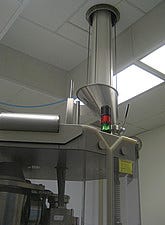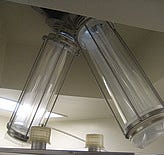Anti-Segregation Technologies Result in Dramatic Yield Increase
June 4, 2010
“Our material handling process was very inefficient and we were lucky to yield 50% in-spec product,” says the director of a major generic pharmaceutical company, referring to a problem his company had with manufacturing one of its key products, “and the handling labor was extensive. I can’t even begin to tell you how frustrating it was.”
|
CPS's patented EZ-Down system prevents product segregation by eliminating product free-fall |
The Problem
“Saying this formulation was a challenge is an understatement,” he continued. “The majority of the ingredients are fines blended with large spherical granules. Any movement or disturbance causes the spheres to float to the top of the batch. We knew that the main cause of the low yields was due to ingredient segregation occurring between the V-blender and the tablet press but we were at a loss to find a feasible cure to the segregation issue.”
The yield issues came to the attention of Custom Powder Systems (CPS) during an on-site visit for another on-going project. As the CPS team walked through the process they found the product was loaded into drums from the V-blender. The drums were then moved across the facility into the compression room and hand scooped from drums into the tablet press feed inlets.
Analysis
CPS analyzed the data gathered on-site and identified three major areas where segregation was occurring:
1. The transfer from the V-blender to drums. The distance the product was free-falling into the drum caused the batch ingredients to separate: fines to the bottom and spheres to the top.
2. Transport of drums. The manual handling process of loading full drums onto pallets, moving the pallets across the plant, and elevating to the tablet press inlet further agitated and segregated the product.
3. Scoop Feeding. The process of scooping product out of drums into the tablet press produced a second instance of product free-fall induced segregation.
Initial Recommendations
CPS came back to the client with a recommendation to replace the V-blender and drum transfer with an IBC (bin) blender and IBCs. This type of system would eliminate the first two points of the existing process that induced segregation. The third segregation point would be eliminated by using CPS’s patented EZ-Down system to transfer the product from the IBC to the tablet press.
“CPS’s first recommendation to change to a bin blending system was excellent but we were reluctant to consider anything that may require modification to the ANDA we filed for this drug,” says the director. “We challenged them to come up with an alternate solution that didn’t involve changing the blender.”
|
Bladders inflate to pinch off a flexible downspout, then deflate at a controlled rate to push product through the downspout. |
Rising to the Challenge
CPS came back with a two-part solution. First was to provide a custom designed container, later named the “Transfer Hopper” (TH) and a mobile lift to raise it. The TH is elevated so that the bottom of the hopper is positioned within inches of the bottom of V-blender outlet valve. This assures that the product has almost no free fall into the TH when the blender is emptied. Once the blender valve is opened, the hopper is slowly lowered by the lift, providing a controlled, segregation-free discharge from the blender.
The second part of the solution was CPS’s patented EZ-Down system that prevents product segregation by eliminating product free-fall. This device has a bladder that inflates to pinch off a flexible downspout running between the IBC outlet and the tablet press inlet. Once the IBC valve is opened the bladder is deflated at a controlled rate, allowing the weight of the product to push downward through the flexible downspout in a uniform “slug”.
Results
In the director’s words, “This system exceeded our greatest expectations. Our yields jumped from less than 75% to over 98%, plus we dramatically reduced the labor needed to perform the process. Our return on investment was almost immediate. CPS definitely rose to the challenge and we are now updating our other lines with this system.”
Custom Powder Systems (Springfield, MO) is a leading provider of systems to transport, contain, blend, and process dry materials for pharmaceutical, biopharmaceutical, food, nutrition supplement, and industrial manufacturing. For more information, visit www.custom-powder.com.
You May Also Like




